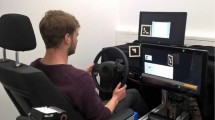Abstract
The communication during human-machine interaction often happens only as a secondary task that distract the user’s main focus on a primary task. In our study, the primary task was driving a vehicle and the secondary task was an interaction with a dialogue system on a tablet device using touch and speech. In this paper we present the design and the analysis of a study that can be used to create an optimal strategy for a dialogue manager that takes into consideration several metrics. These include the type of the information we require from the user, the expected cognitive load on the user, the expected duration of a user’s response and the expected error rate.
Access this chapter
Tax calculation will be finalised at checkout
Purchases are for personal use only
Similar content being viewed by others
Notes
- 1.
Downloadable from https://isotc.iso.org/livelink/livelink?func=ll&objId=11560806.
References
Benedetto, S., Pedrotti, M., Minin, L., Baccino, T., Re, A., Montanari, R.: Driver workload and eye blink duration. Transp. Res. Part F Traffic Psychol. Behav. 14(3), 199–208 (2011). https://doi.org/10.1016/j.trf.2010.12.001
Curin, J., et al.: Dictating and editing short texts while driving. In: Proceedings of the 3rd International Conference on Automotive User Interfaces and Interactive Vehicular Applications - AutomotiveUI 2011 p. 13 (2011). http://dl.acm.org/citation.cfm?doid=2381416.2381418
He, J., et al.: Texting while driving: is speech-based text entry less risky than handheld text entry? Accid. Anal. Prev. 72, 287–295 (2014). https://doi.org/10.1016/j.aap.2014.07.014
Road vehicles – Ergonomic aspects of transport information and control systems – Simulated lane change test to assess in-vehicle secondary task demand. Standard, International Organization for Standardization, Geneva, CH, September 2010
Kousidis, S., Kennington, C., Baumann, T., Buschmeier, H., Kopp, S., Schlangen, D.: A multimodal in-car dialogue system that tracks the driver’s attention. In: Proceedings of the 16th International Conference on Multimodal Interaction - ICMI 2014, pp. 26–33 (2014). http://dl.acm.org/citation.cfm?doid=2663204.2663244
Louveton, N., McCall, R., Koenig, V., Avanesov, T., Engel, T.: Driving while using a smartphone-based mobility application: evaluating the impact of three multi-choice user interfaces on visual-manual distraction. Appl. Ergon. 54, 196–204 (2016). https://doi.org/10.1016/j.apergo.2015.11.012
Oviatt, S., Coulston, R., Lunsford, R.: When do we interact multimodally? Cognitive load and multimodal communication patterns. In: International Conference on Multimodal Interfaces, pp. 129–136 (2004). http://dl.acm.org/citation.cfm?id=1027957
Pitts, M.J., Skrypchuk, L., Wellings, T., Attridge, A., Williams, M.A.: Evaluating user response to in-car haptic feedback touchscreens using the lane change test. Adv. Hum. Comput. Interact. 2012 (2012). https://doi.org/10.1155/2012/598739
Pražák, A., Psutka, J.V., Hoidekr, J., Kanis, J., Müller, L., Psutka, J.: Automatic online subtitling of the Czech parliament meetings. In: Sojka, P., Kopeček, I., Pala, K. (eds.) TSD 2006. LNCS (LNAI), vol. 4188, pp. 501–508. Springer, Heidelberg (2006). https://doi.org/10.1007/11846406_63
Silvervarg, A., et al.: Perceived usability and cognitive demand of secondary tasks in spoken versus visual-manual automotive interaction. In: Proceedings of the Annual Conference of the International Speech Communication Association, INTERSPEECH, pp. 1171–1175 (2016). https://doi.org/10.21437/Interspeech.2016-99
Tihelka, D., Stanislav, P.: ARTIC for assistive technologies: transformation to resource-limited hardware. In: WCECS 2011, vol. I, pp. 581–584 (2011)
Acknowledgments
This work was supported by the European Regional Development Fund under the project Robotics for Industry 4.0 (reg. no. CZ.02.1.01/0.0/0.0/15_003/0000470).
Author information
Authors and Affiliations
Corresponding author
Editor information
Editors and Affiliations
Rights and permissions
Copyright information
© 2018 Springer Nature Switzerland AG
About this paper
Cite this paper
Chýlek, A., Šmídl, L., Nedvěd, J. (2018). Choosing a Dialogue System’s Modality in Order to Minimize User’s Workload. In: Karpov, A., Jokisch, O., Potapova, R. (eds) Speech and Computer. SPECOM 2018. Lecture Notes in Computer Science(), vol 11096. Springer, Cham. https://doi.org/10.1007/978-3-319-99579-3_12
Download citation
DOI: https://doi.org/10.1007/978-3-319-99579-3_12
Published:
Publisher Name: Springer, Cham
Print ISBN: 978-3-319-99578-6
Online ISBN: 978-3-319-99579-3
eBook Packages: Computer ScienceComputer Science (R0)




